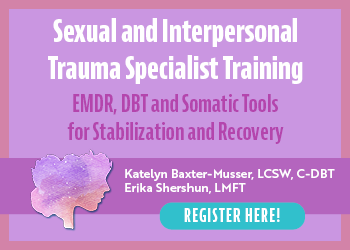- Identify physical, emotional, and sexual abuse in clinical settings
- Key screening and assessment tools
- Grounding techniques to stabilize clients
- EMDR and DBT strategies for complex relational trauma (no previous EMDR or DBT training necessary)
- Build emotional and physical resilience in survivors
- Deep dive into the psychological effects of sexual trauma
- Tools to manage triggers, flashbacks, and dissociation
- Somatic techniques to regulate nervous system responses
- Address shame, grief, nightmares, and intimacy issues
- Guide clients in building healthy boundaries
- Up to 14.25 CE hours in over 14 hours of on-demand video
- FREE bonus video from Janina Fisher on trauma stabilization
- Unlimited access to resources
- Certificate of completion

$629.97
Value
Just $199.99!
Sexual and interpersonal trauma strikes at the heart of trust and intimacy, often coming from those who were supposed to protect your clients.
These wounds can disrupt their sense of safety, leaving them struggling with relationships, body image, and persistent symptoms.
And even experienced therapists can misstep, such as unintentionally invalidating clients, sticking too rigidly to one model, or overlooking crucial issues.
That's why we've put together a game-changing dual-course training with trauma experts Erika Shershun, LMFT, and Katelyn Baxter-Musser, LCSW, C-DBT.
This isn't just another course—it's your key to providing the specialized care your clients desperately need.
In the first part, you'll dive into sexual trauma's impact and get actionable techniques to truly support survivors. Then, in the second segment, you'll level up your skills by integrating EMDR (no prior EMDR training needed) and DBT to enhance client readiness and tackle trauma-related relational challenges.
In becoming a specialist, you'll gain:
- A deep understanding of sexual trauma's effects to support your clients with empathy.
- Proven strategies for sensitive conversations that build trust and transparency.
- Empowering somatic techniques to manage triggers, flashbacks, and dissociation.
- Strategies to rebuild boundaries and help clients take back control of their lives.
- Enhanced EMDR readiness and emotional management (no prior EMDR training needed).
- DBT skills to boost interpersonal functioning and tailor trauma interventions.
Plus, as an exclusive bonus, you'll gain access to Janina Fisher's Trauma-Informed Stabilization treatment seminar, along with over 50 embodied practices from Catherine Cook-Cottone's Embodied Healing Workbook — designed to help clients reconnect with their bodies and promote deep healing.
This is your chance to transform how you approach trauma treatment and make a lasting difference in your clients' lives. Don't miss out!
EMDR, DBT, and Somatic Tools for Stabilization and Recovery
Click here for Credit details | Click here for course objectives and outline

Integrated Toolkit for Survivors of Physical, Emotional and Sexual Abuse
Katelyn Baxter-Musser, LCSW, C-DBT | Click here for information about Katelyn Baxter-Musser
- Exploring physical, emotional, and sexual abuse
- Neurobiological, physiological, and psychological processes involved
- Long-term consequences of interpersonal trauma
- Recognizing risk factors
- Prevalence rates and barriers to disclosure of interpersonal trauma
- Impacts on relationships with others and oneself
Assess for Interpersonal Trauma in the Clinical Setting
- Recognizing warning signs, symptoms, and comorbidities
- Differentiating physical, emotional, and sexual abuse in the clinical context
- Screening and assessment measures for identifying trauma in clients
- Trauma Symptom Inventory
- CAPS
- Dissociative Experiences Scale
- Developing a trauma-informed approach
DBT Skills for Trauma-Related Symptoms, Triggers, and More
- Research on DBT and survivors of interpersonal violence
- DBT components and how the biosocial theory relates to trauma
- Goal and targets of treatment
- DBT tools for managing crises and creating safety plans
- DBT validation strategies and creating a safe therapeutic environment
- How DBT helps clients set healthy boundaries
- How the AIP model relates to trauma processing
- Characteristics and phases of EMDR
- Goal and targets of EMDR therapy
- Challenges and complexities of working with survivors of IPV
- Managing dissociation and other challenges
- Resourcing and grounding techniques to enhance stabilization and containment
Integrating EMDR and DBT in Trauma Work: Enhancing Resilience and Coping During Stabilization and Trauma Processing
- How EMDR and DBT complement each other/li>
- Assessing clients' needs and treatment priorities
- Common goals for survivors of interpersonal violence
- DBT treatment planning strategies to identify specific targets for EMDR
- Enhancing EMDR readiness with DBT emotional regulation skills
- DBT coping skills for calm and focus in EMDR sessions
- 5 practical ways to fuse DBT skills directly into EMDR sessions
- Case studies
- Research, risks, and limitations

Interventions to Cultivate Safety, Release Shame, and Nurture Boundaries
Erika Shershun, LMFT | Click here for information about Erika Shershun
- In-depth exploration of the psychological effects of sexual trauma
- Comprehensive examination of the nuanced manifestations of trauma
- Advanced strategies for therapeutic conversations with clients
- Therapeutic techniques to facilitate somatic safety in clients
- Guided experiential exercises to enhance personal and professional presence and attunement
Decoding the Role of the Nervous System
- The intricate interplay between the nervous system and trauma responses
- In-depth exploration and application of polyvagal theory
- Skillful identification and assessment of different nervous system states and their influence on client reactions
- Techniques to facilitate state shifts and find regulation
Mastering Memory, Triggers, Flashbacks, and Dissociation
- Breakdown of the complex dynamics surrounding memory, triggers, flashbacks, and dissociation in the context of sexual trauma
- The intricate relationship between trauma and memory processes
- Practical tools to manage triggers and process flashbacks
- Skillful interventions for dissociative experiences and restoring a sense of safety and control over client narratives
- Assessment of the impact on boundaries as a result of sexual trauma
- Advanced strategies to facilitate clients in embodying and articulating healthy boundaries
- Techniques to rebuild a coherent sense of self and agency
- Self-care exercises to mitigate vicarious trauma and burnout
Cultivating Emotional and Physical Resilience
- Understanding the emotional landscape experienced by sexual trauma survivors
- Advanced interventions to address complex emotional experiences, including anger, rage, shame, grief, nightmares, and intimacy issues
- Techniques to guide clients through the intricate terrain of complex emotions
- Strategies for emotional and physical resilience
- Processes to thrive beyond the impact of traumatic experiences
Ethical Considerations
- Scope of practice
- Limitations of research
- Counselor self-care
- Referrals and healthcare collaboration
EMDR, DBT, and Somatic Tools for Stabilization and Recovery
Click here for Credit details | Click here for course objectives and outline

Janina Fisher, PhD | Click here for information about Janina Fisher
Trauma treatment is rarely straightforward. Clients want help but resist connecting emotionally. Many are tormented by critical self-hating thoughts or want to die, jeopardizing their ability to process the trauma. TIST is a new trauma-informed treatment that directly addresses the challenges, not just the events, of a traumatic past. In TIST, we view these trauma-related thoughts, emotions, and impulses as communications from fragmented, disowned trauma-related parts. When clients form meaningful attachment relationships to these young, rejected parts, the trauma often resolves spontaneously. When the parts finally experience safety and care, the traumatic past feels done and behind them.

By Catherine Cook-Cottone, PhD, C-IAYT
Packed with over 50 embodied practices, worksheets, and meditations, this special bonus provides a step-by-step, sequential process for embodied healing, featuring six chapters to work through with your clients.
- Chapter 1: Connecting to Your Embodied Self — Learn how to foster self-awareness and reconnect with your body in a compassionate way.
- Chapter 2: Understanding Your Protective Body — Explore how trauma shapes bodily responses and how to gently unravel protective patterns.
- Chapter 3: Identifying Stress Triggers and Your Window of Tolerance — Gain tools to recognize triggers and help clients create a framework for self-regulation.
- Chapter 4: Creating Safety and Care Routines for Your Body — Develop practical strategies for nurturing a safe and caring environment for healing.
- Chapter 5: Developing Resources and the Power of the Embodied "Why" — Tap into intrinsic motivations that support resilience and healing.
- Chapter 6: Embodied Practices for Transformation — Engage in practices that promote deep, transformative healing.
We’re that confident you'll find this learning experience to be all that's promised and more than you expected.
EMDR, DBT, and Somatic Tools for Stabilization and Recovery
Click here for Credit details | Click here for course objectives and outline

